Does your dog get stressed out when traveling? Do they pant and never seem to settle? Travel anxiety can ruin a road trip before you even leave. Fortunately, there are many things you can do to help your furry friend become a better traveler. SIXT.VN understands the importance of a smooth and enjoyable travel experience for both you and your pet in Vietnam. Explore practical tips, calming aids, and travel services designed to keep your dog relaxed and happy during your journey. Consider booking your airport transfer with SIXT.VN.
1. Understanding Car Sickness in Dogs
Does your dog experience nausea when riding in the car? It’s a common issue that can often lead to travel anxiety. Puppies are more prone to motion sickness, but many outgrow it by the time they reach one year old. Feeling sick in the car can create negative associations, making your dog anxious about car rides.
1.1. How to Help a Dog With Car Sickness?
Check out resources like “Preventing and Treating Car Sickness in Dogs” for helpful advice.
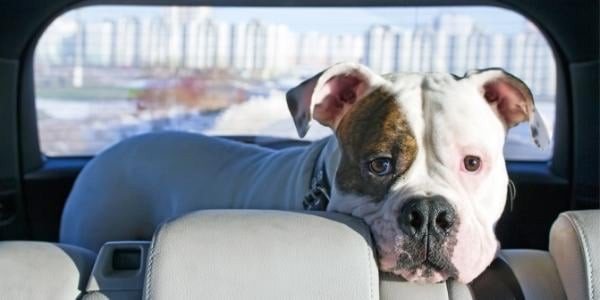 American bulldog terrier anxious about riding in the car with alt text dog experiencing travel anxiety in a car
American bulldog terrier anxious about riding in the car with alt text dog experiencing travel anxiety in a car
2. Creating a Comfortable Car Environment for Your Dog
Why does your dog get anxious in the car? For many dogs, the primary reason for car rides is visits to the veterinarian. This leads to a negative association: car ride equals vet visit. This is an example of classical conditioning, where a dog associates the car with an unpleasant experience, triggering stress and anxiety. Other dogs may become anxious due to past negative experiences in the car, such as being left alone or a traumatic event like a car accident.
Pro Tip: Enhance your dog’s comfort by following these additional tips to make vet visits less stressful.
2.1. Desensitization and Counterconditioning Techniques
Can you prevent or modify negative associations with car rides? Yes, you can prevent negative associations by starting young and using desensitization techniques. For dogs that already exhibit anxiety, counterconditioning can help modify those associations. The key to both methods is to proceed slowly and gradually.
2.2. Desensitizing a Puppy to Enjoy Car Rides (Prevention)
How can you introduce your puppy to car rides in a positive way? Follow these steps:
-
Start in the Car’s Vicinity: Begin by having your puppy spend time near the car without actually getting in. Provide treats and praise to create positive associations.
-
Introduce the Car: Gradually introduce your puppy to the inside of the car. Let them explore and get comfortable, offering treats and praise.
-
Behind the Wheel: Once your dog is comfortable in their area, sit behind the wheel. Toss treats and praise them when they are quiet and calm. Use a stuffed Kong or Toppl to build a positive association with staying calm and being further away from you in the car.
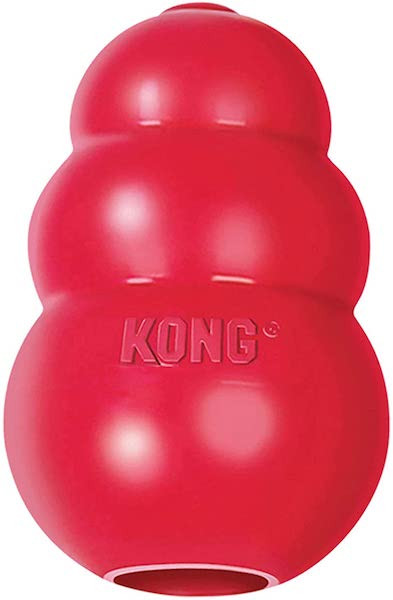 Kong stuffable dog toy with alt text Kong Classic dog toy for calming anxious dogs
Kong stuffable dog toy with alt text Kong Classic dog toy for calming anxious dogs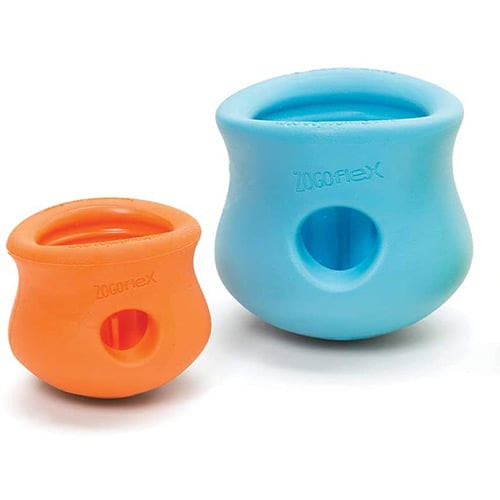 West Paw Toppl Interactive Feeder with alt text West Paw Toppl Interactive Feeder for dog anxiety
West Paw Toppl Interactive Feeder with alt text West Paw Toppl Interactive Feeder for dog anxiety -
Engine On: Practice with the car turned off, then introduce turning the car on. Keep your energy neutral, turn the car on briefly, and then off. Toss a treat right after the noise.
-
Increase Engine Time: Gradually increase the time the engine is running, ensuring your pup remains calm and happy with praise and treats.
-
Recognize Fear Responses: Watch for signs of fear, such as backing away, ears pinned back, or wide eyes. If you notice these, offer comfort and reduce the intensity of the step.
-
Add Car Ride Elements: Gradually add more elements of a car ride, such as backing out of the driveway or a quick trip around the block, always reinforcing calm behavior with praise and treats. Take your puppy to enjoyable places, so they learn that car rides lead to positive experiences.
2.3. Counterconditioning Your Anxious Dog (Treatment)
How can you help a dog that already has negative associations with the car? The steps are similar to desensitization, but the focus is on rewarding your dog’s choice to approach the car.
- Start Slow: Begin outside the parked car. Treat and praise your dog any time they look at the car.
- Build Confidence: Open the car door and repeat the process, rewarding them for looking at and moving towards the car. Avoid forcing them into the car; let them choose to approach the open door.
- Reward Progress: Once they show confidence, reward them for jumping in or being placed in the car. Give praise and treats when their feet are in the car, then let them jump out if they want.
- Sit in the Car: Sit in the back seat with your dog, petting, praising, and giving high-value treats.
- Build Duration: Gradually increase the time spent in the car. Consider feeding meals in the car or sitting calmly with them.
- Weather Considerations: Avoid these exercises on hot or cold days and always stay with your dog.
What are you trying to achieve with counterconditioning? The goal is to change your dog’s negative associations to positive ones. Associate the car with their favorite things, such as food, toys, or massages. Start with short trips around town to gradually get them more comfortable, going to fun places like dog parks or pet stores. Increase the distance gradually, taking different routes each time.
2.3.1. Consulting Professionals
When should you seek professional help? Talk to your veterinarian or a veterinary behaviorist early on to explore supplements or medications that can help your dog stay calm. A certified dog trainer can also assist in managing this behavior modification process by identifying stress signals and planning a step-by-step program.
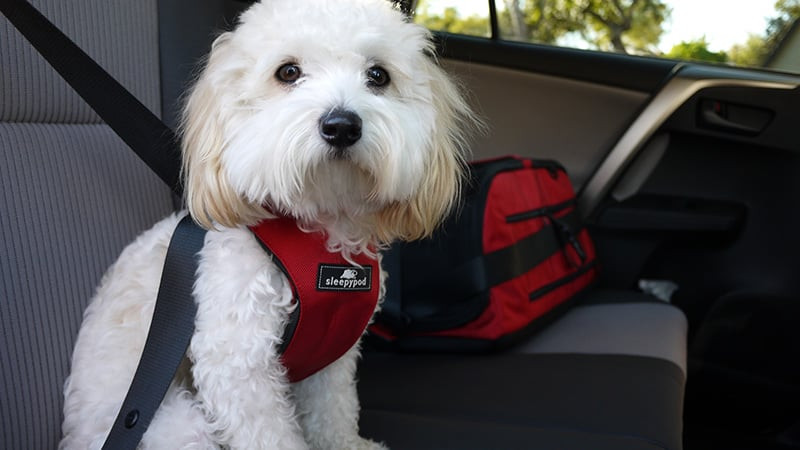 safest recommended dog sleepypod travel harness with alt text Sleepypod Clickit dog travel harness for car safety
safest recommended dog sleepypod travel harness with alt text Sleepypod Clickit dog travel harness for car safety
3. Calming Aids for Your Dog
What products and tricks can help calm your dog in the car? It’s often a process of trial and error to find what works best for your dog.
3.1. Familiar Scents and Anti-Anxiety Jackets
How can familiar scents and clothing help? Providing a favorite toy or an article of clothing with your scent can calm your dog. Be cautious and ensure your dog won’t chew and ingest the items. Consider using a Thundershirt anxiety-reducing jacket. These jackets can help calm dogs in various situations, including car travel.
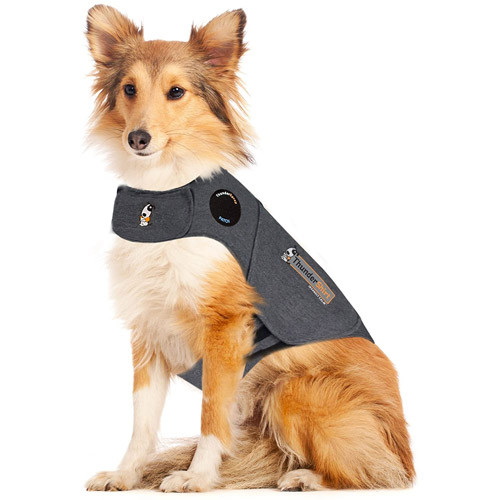 thundershirt for dogs with alt text Thundershirt anxiety jacket for calming dogs
thundershirt for dogs with alt text Thundershirt anxiety jacket for calming dogs
3.2. Calming Supplements
Which calming supplements are effective for dogs? Several calming supplements can help dogs relax. Consult with your vet to determine the best options for your dog. Some popular choices include:
-
Solliquin Calming Treats
-
Vetoquinol Zylkene Behavior Support Capsules
-
VetriScience Calm & Confident Chews
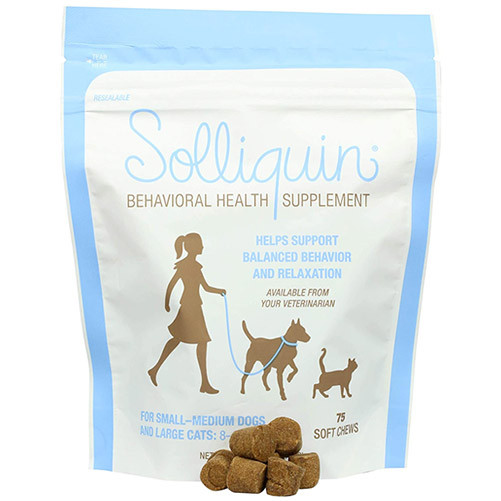 solliquin calming treats with alt text Solliquin calming treats for anxious dogs
solliquin calming treats with alt text Solliquin calming treats for anxious dogs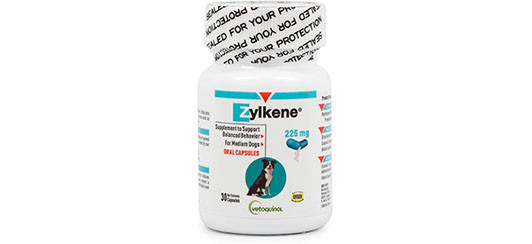 zylkene calming supplement for dogs with alt text Zylkene calming supplement for dog travel anxiety
zylkene calming supplement for dogs with alt text Zylkene calming supplement for dog travel anxiety
3.3. Probiotics for Dogs
How do probiotics help with travel anxiety? Research has shown a link between a dog’s gut microbiome and their nervous system, brain, and behavior. Probiotics enhance the gut microbiome, which can lessen anxiety and modify behavior. They help mitigate stress-induced symptoms like vomiting. Purina’s Calming Care is a recommended option, but it may take up to a month to notice benefits.
3.4. Calming Pheromones
What are calming pheromones and how do they work? Pheromones are chemical signals that help animals communicate. Adaptil™ (Comfort Zone) mimics the pheromone released by female dogs to calm their puppies. It is available in spray and collar form. Spray it on a toy or blanket or use the Adaptil Comfort Zone Collar to help decrease anxiety.
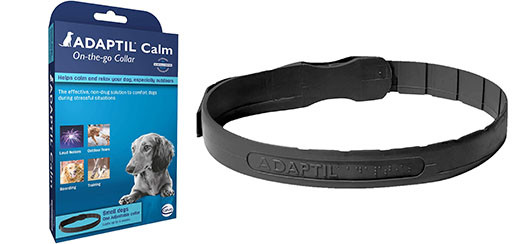 Adaptil calming dog collar with alt text Adaptil calming collar for anxious dogs
Adaptil calming dog collar with alt text Adaptil calming collar for anxious dogs
3.5. Homeopathic Remedies
What are homeopathic remedies for calming pets? Homeopathic remedies, like Bach Rescue Remedy Pet, contain essences of flowers and plants believed to calm anxiety. Give a dose every four hours in your dog’s water, food, or directly into their mouth, starting a day or two before travel.
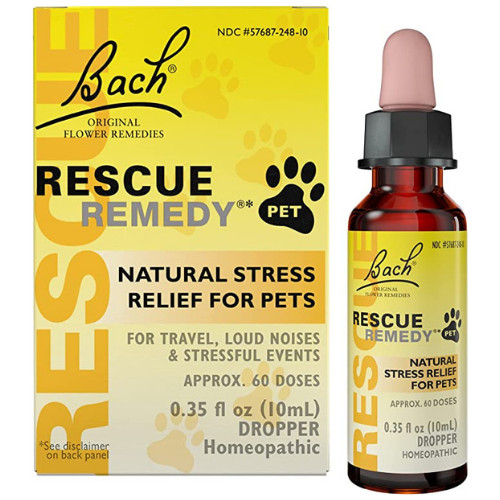 rescue remedy for pets with alt text Rescue Remedy for calming pet travel anxiety
rescue remedy for pets with alt text Rescue Remedy for calming pet travel anxiety
3.6. The Car Environment
How can the car environment affect your dog’s anxiety? Soothing music or fresh air can help. Play classical music, soft rock, or reggae. Open the windows slightly, but ensure your dog does not put their head out to avoid injuries.
4. Ensuring Your Dog’s Safety and Security
Why is it important to buckle up your dog? Some dogs feel less anxious when physically secure. Travel crates, carriers, and harnesses provide security and keep them steady. The best restraint depends on your dog’s size, comfort level, and vehicle type. Restraints also protect your dog and other occupants during travel.
5. Medications for Travel Anxiety and Car Sickness
When is medication necessary? Sometimes, despite acclimation and calming techniques, your dog may still need medication. Consult with your veterinarian for specifics. Only your vet can determine the best medications or combinations of medications and supplements.
5.1. Types of Medications
What types of medications might your veterinarian prescribe? Here are some examples:
-
Antihistamines: Like diphenhydramine (Benadryl®), which can lessen anxiety and reduce car sickness through drowsiness and balance effects.
-
Anxiolytics: Reduce or block anxiety and may cause sedation.
-
Sedatives: Reduce awareness and agitation by decreasing perception of surroundings.
-
Neurokinin Receptor Blocker: Cerenia® blocks the vomiting reflex and is highly effective at preventing vomiting.
Important Note: Always consult with your veterinarian before giving any medication to your dog.
What are the key takeaways for traveling with an anxious dog in Vietnam? Remember to prioritize gradual acclimation, create positive associations, use calming aids, ensure safety, and consult with your veterinarian when necessary.
5.2. Vietnam Travel Services with SIXT.VN
How can SIXT.VN help with your travel needs in Vietnam? SIXT.VN offers various services to make your trip easier and more enjoyable:
- Airport Transfers: Ensure a smooth and stress-free start to your journey with reliable airport transfer services.
- Hotel Booking: Find the perfect accommodation to suit your needs and budget.
- Tours: Explore Hanoi and other popular destinations with guided tours.
- Flight Booking: Get the best deals on flights to and from Vietnam.
5.3. Why Choose SIXT.VN for Your Vietnam Trip?
What are the benefits of using SIXT.VN? SIXT.VN provides convenience, reliability, and excellent support for your travel needs in Vietnam. Enjoy a hassle-free experience with services designed to make your trip memorable and enjoyable.
6. Addressing Common Travel Concerns
What challenges do travelers face when bringing their dogs to Vietnam? Some common concerns include:
- Planning a Detailed Itinerary: It can be challenging to create a pet-friendly travel plan.
- Language and Cultural Barriers: Communicating your needs and understanding local customs can be difficult.
- Finding Reliable and Quality Services: Ensuring your pet receives the best care and attention.
- Transportation and Navigation: Getting around with a dog can be tricky.
- Booking Accommodations and Services: Finding pet-friendly hotels and services.
6.1. How SIXT.VN Overcomes These Challenges
How does SIXT.VN help alleviate these concerns? SIXT.VN offers services that provide solutions to these challenges:
- Tailored Travel Advice: Personalized itineraries that cater to your and your dog’s needs.
- Bilingual Support: Assistance in overcoming language barriers.
- Trusted Services: Recommendations for reliable and high-quality pet services.
- Easy Transportation: Options for convenient and pet-friendly transportation.
- Comprehensive Booking: Assistance with booking pet-friendly accommodations and services.
7. Vietnam Travel Tips for Dog Owners
What should dog owners know when traveling to Vietnam? Here are some essential tips:
7.1. Pre-Travel Preparations
What steps should you take before traveling?
- Vaccinations and Health Checks: Ensure your dog is up-to-date on vaccinations and in good health.
- Pet Passport and Documentation: Obtain the necessary travel documents for your dog.
- Microchipping: Ensure your dog has a microchip with current contact information.
7.2. During Your Stay
How can you ensure a smooth trip during your stay?
- Pet-Friendly Accommodations: Book hotels that welcome pets.
- Local Veterinarians: Know the locations of nearby veterinary clinics.
- Essential Supplies: Pack food, water, bowls, and other essentials.
7.3. Exploring Hanoi with Your Dog
What are some dog-friendly activities in Hanoi?
- Parks and Green Spaces: Visit parks like Thong Nhat Park for walks.
- Cafés and Restaurants: Find pet-friendly establishments with outdoor seating.
- Walking Tours: Explore the city on foot, ensuring your dog can join you.
8. Testimonials and Success Stories
What experiences have other travelers had with SIXT.VN? Hear from satisfied customers who have used SIXT.VN’s services to travel with their dogs in Vietnam. These stories highlight the convenience, reliability, and support provided by SIXT.VN, ensuring a positive and stress-free travel experience.
9. Understanding Your Dog’s Travel Anxiety
Why is it important to understand your dog’s anxiety? Recognizing the signs of anxiety and addressing the root causes can significantly improve your dog’s travel experience. Be patient, provide comfort, and seek professional help when needed.
9.1. Signs of Anxiety
What are the common signs of travel anxiety in dogs?
- Excessive Panting
- Restlessness
- Whining or Barking
- Trembling
- Pacing
9.2. Addressing the Root Causes
How can you identify and address the causes of anxiety?
- Past Experiences: Consider previous negative experiences in the car.
- Motion Sickness: Address any issues with motion sickness.
- Lack of Familiarity: Gradually introduce your dog to car travel.
10. Frequently Asked Questions (FAQ)
10.1. What are the best calming aids for dogs during travel?
The best calming aids include Thundershirts, calming supplements like Solliquin and Zylkene, pheromone sprays like Adaptil, and homeopathic remedies like Rescue Remedy.
10.2. How can I prepare my dog for a long car ride?
Prepare your dog by gradually acclimating them to the car, using positive reinforcement, providing familiar scents, and ensuring they are comfortable and secure.
10.3. Is it safe to give my dog medication for travel anxiety?
It is safe to give your dog medication for travel anxiety if prescribed by a veterinarian. Always consult with your vet before administering any medication.
10.4. What should I pack for my dog when traveling?
Pack food, water, bowls, toys, bedding, leash, waste bags, and any necessary medications.
10.5. How often should I stop for breaks during a long car ride with my dog?
Stop for breaks every 2-3 hours to allow your dog to stretch, relieve themselves, and get some fresh air.
10.6. Are there any natural remedies for dog travel anxiety?
Natural remedies include calming supplements, pheromone sprays, and homeopathic remedies.
10.7. How can I make the car ride more comfortable for my dog?
Make the car ride more comfortable by providing a comfortable space, playing calming music, ensuring good ventilation, and using familiar scents.
10.8. What are the signs of car sickness in dogs?
Signs of car sickness include excessive drooling, vomiting, restlessness, and panting.
10.9. Can probiotics help with dog travel anxiety?
Yes, probiotics can help by improving gut health and reducing stress-induced symptoms.
10.10. What should I do if my dog is extremely anxious during car rides?
If your dog is extremely anxious, consult with your veterinarian or a veterinary behaviorist for professional advice and potential medication options.
SIXT.VN is dedicated to ensuring your travel experience in Vietnam is seamless and enjoyable for both you and your dog. From airport transfers to pet-friendly accommodations, we’ve got you covered. Contact us today to start planning your next adventure!
Address: 260 Cau Giay, Hanoi, Vietnam
Hotline/Whatsapp: +84 986 244 358
Website: SIXT.VN



